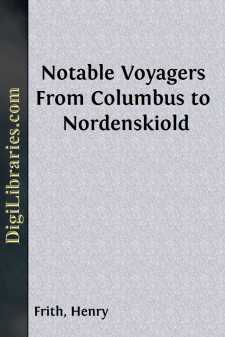Categories
- Antiques & Collectibles 13
- Architecture 36
- Art 48
- Bibles 22
- Biography & Autobiography 813
- Body, Mind & Spirit 142
- Business & Economics 28
- Children's Books 14
- Children's Fiction 11
- Computers 4
- Cooking 94
- Crafts & Hobbies 4
- Drama 346
- Education 46
- Family & Relationships 57
- Fiction 11828
- Games 19
- Gardening 17
- Health & Fitness 34
- History 1377
- House & Home 1
- Humor 147
- Juvenile Fiction 1873
- Juvenile Nonfiction 202
- Language Arts & Disciplines 88
- Law 16
- Literary Collections 686
- Literary Criticism 179
- Mathematics 13
- Medical 41
- Music 40
- Nature 179
- Non-Classifiable 1768
- Performing Arts 7
- Periodicals 1453
- Philosophy 64
- Photography 2
- Poetry 896
- Political Science 203
- Psychology 42
- Reference 154
- Religion 513
- Science 126
- Self-Help 84
- Social Science 81
- Sports & Recreation 34
- Study Aids 3
- Technology & Engineering 59
- Transportation 23
- Travel 463
- True Crime 29
Notable Voyagers From Columbus to Nordenskiold
by: Henry Frith
Description:
Excerpt
Introduction—A.D. 1486.
Columbus before the conclave of Professors at Seville—His parentage and early history—Battle with Venetian galleys—Residence in Portugal—Marries widow of a navigator—Grounds on which he founded his theory—Offers his services to the King of Portugal—His offer declined—Sends his brother Bartholomew to Henry the Seventh of England—Don John sends out a squadron to forestall him—Sets off for Spain—Introduced by the Duke of Medina Celi to Queen Isabella—She encourages him—Plan for the recovery of the Holy Sepulchre—His long detention at Court while Ferdinand and Isabella are engaged in the war against the Moors of Granada—A hearing at length afforded him—His demands refused—Leaves the Court in poverty and visits Palos on his way to France—Met by Juan Perez, Prior of the Rabida convent—The Prior listens to his plans—Introduces him to the Pinzons, and informs the Queen of his intended departure—Sent for back at Court—All his demands agreed to—Authority given him to fit out a squadron.
In the year 1486 a council of learned professors of geography, mathematics, and all branches of science, erudite friars, accomplished bishops, and other dignitaries of the Church, were seated in the vast arched hall of the old Dominican convent of Saint Stephen in Salamanca, then the great seat of learning in Spain. They had met to hear a simple mariner, then standing in their midst, propound and defend certain conclusions at which he had arrived regarding the form and geography of the earth, and the possibility, nay, the certainty, that by sailing west, the unknown shores of Eastern India could be reached. Some of his hearers declared it to be grossly presumptuous in an ordinary man to suppose, after so many profound philosophers and mathematicians had been studying the world, and so many able navigators had been sailing about it for years past, that there remained so vast a discovery for him to make. Some cited the books of the Old Testament to prove that he was wrong, others the explanations of various reverend commentators. Doctrinal points were mixed up with philosophical discussions, and a mathematical demonstration was allowed no weight if it appeared to clash with a text of Scripture or comment of one of the fathers.
Although Pliny and the wisest of the ancients had maintained the possibility of an antipodes in the southern hemisphere, these learned gentlemen made out that it was altogether a novel theory.
Others declared that to assert there were inhabited lands on the opposite side of the globe would be to maintain that there were nations not descended from Adam, as it would have been impossible for them to have passed the intervening ocean, and therefore discredit would be thrown on the Bible.
Again, some of the council more versed in science, though admitting the globular form of the earth, and the possibility of an opposite habitable hemisphere, maintained that it would be impossible to arrive there on account of the insupportable heat of the torrid zone; besides which, if the circumference of the earth was as great as they supposed, it would require three years to make the voyage....


